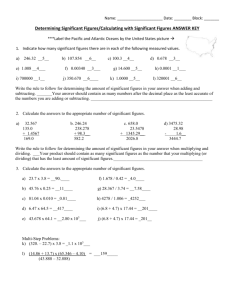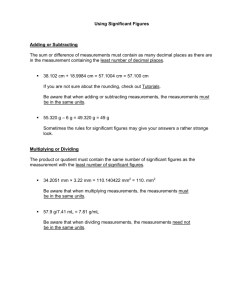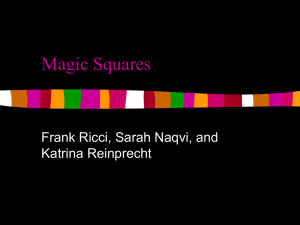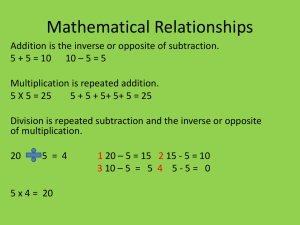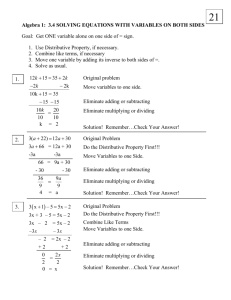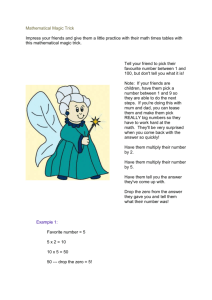Negative Numbers
advertisement
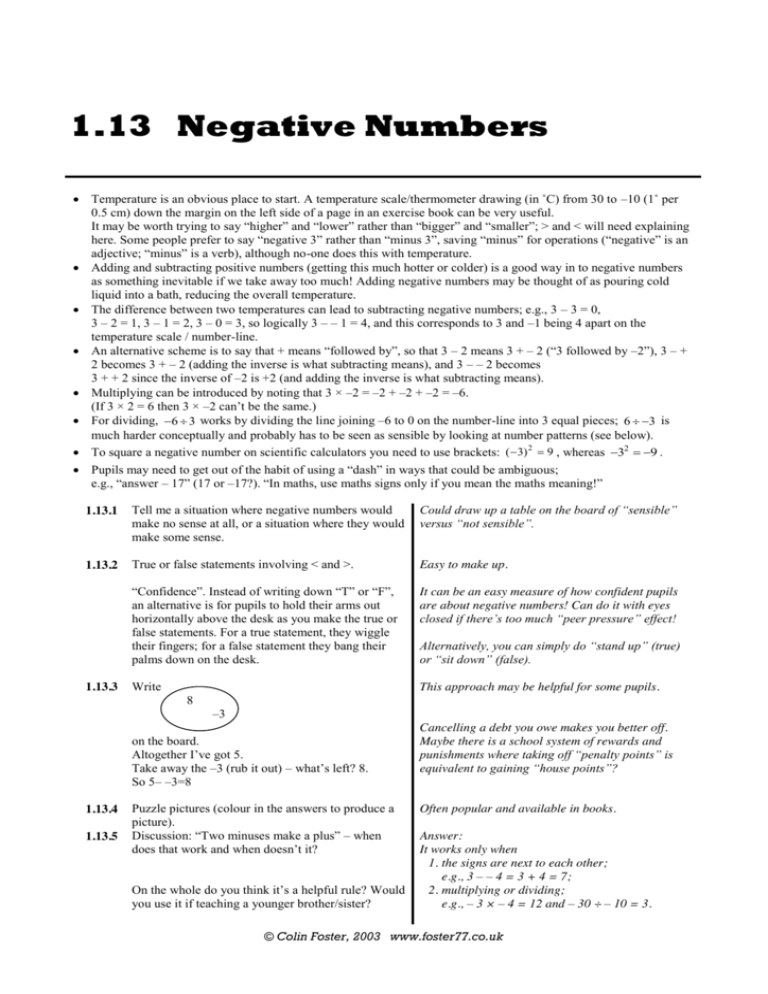
1.13 Negative Numbers Temperature is an obvious place to start. A temperature scale/thermometer drawing (in ˚C) from 30 to –10 (1˚ per 0.5 cm) down the margin on the left side of a page in an exercise book can be very useful. It may be worth trying to say “higher” and “lower” rather than “bigger” and “smaller”;; > and < will need explaining here. Some people prefer to say “negative 3” rather than “minus 3”, saving “minus” for operations (“negative” is an adjective;; “minus” is a verb), although no-one does this with temperature. Adding and subtracting positive numbers (getting this much hotter or colder) is a good way in to negative numbers as something inevitable if we take away too much! Adding negative numbers may be thought of as pouring cold liquid into a bath, reducing the overall temperature. The difference between two temperatures can lead to subtracting negative numbers; e.g., 3 – 3 = 0, 3 – 2 = 1, 3 – 1 = 2, 3 – 0 = 3, so logically 3 – – 1 = 4, and this corresponds to 3 and –1 being 4 apart on the temperature scale / number-line. An alternative scheme is to say that + means “followed by”, so that 3 – 2 means 3 + – 2 (“3 followed by –2”), 3 – + 2 becomes 3 + – 2 (adding the inverse is what subtracting means), and 3 – – 2 becomes 3 + + 2 since the inverse of –2 is +2 (and adding the inverse is what subtracting means). Multiplying can be introduced by noting that 3 × –2 = –2 + –2 + –2 = –6. (If 3 × 2 = 6 then 3 × –2 can’t be the same.) For dividing, 6 3 works by dividing the line joining –6 to 0 on the number-line into 3 equal pieces; 6 3 is much harder conceptually and probably has to be seen as sensible by looking at number patterns (see below). To square a negative number on scientific calculators you need to use brackets: ( 3) 2 9 , whereas 32 9 . Pupils may need to get out of the habit of using a “dash” in ways that could be ambiguous;; e.g., “answer – 17” (17 or –17?). “In maths, use maths signs only if you mean the maths meaning!” 1.13.1 Tell me a situation where negative numbers would make no sense at all, or a situation where they would make some sense. Could draw up a table on the board of “sensible” versus “not sensible”. 1.13.2 True or false statements involving < and >. Easy to make up. “Confidence”. Instead of writing down “T” or “F”, an alternative is for pupils to hold their arms out horizontally above the desk as you make the true or false statements. For a true statement, they wiggle their fingers; for a false statement they bang their palms down on the desk. It can be an easy measure of how confident pupils are about negative numbers! Can do it with eyes closed if there’s too much “peer pressure” effect! Write This approach may be helpful for some pupils. 1.13.3 Alternatively, you can simply do “stand up” (true) or “sit down” (false). 8 –3 on the board. Altogether I’ve got 5. Take away the –3 (rub it out) – what’s left? 8. So 5– –3=8 1.13.4 1.13.5 Puzzle pictures (colour in the answers to produce a picture). Discussion: “Two minuses make a plus” – when does that work and when doesn’t it? Cancelling a debt you owe makes you better off. Maybe there is a school system of rewards and punishments where taking off “penalty points” is equivalent to gaining “house points”? Often popular and available in books. Answer: It works only when 1. the signs are next to each other; e.g., 3 – – 4 = 3 + 4 = 7; On the whole do you think it’s a helpful rule? Would 2. multiplying or dividing; you use it if teaching a younger brother/sister? e.g., – 3 × – 4 = 12 and – 30 ÷ – 10 = 3. © Colin Foster, 2003 www.foster77.co.uk Most rules have a limited range of situations in which they’re appropriate; e.g., scientific laws. It doesn’t work in any other situation; e.g., it doesn’t apply to – 3 – 4 = – 7. (If it’s – 3˚C and it gets 4˚C colder, it goes down to – 7˚C.) Negative co-ordinates are a useful context. 1. If three vertices of a rectangle are (–3,1), (2,1), (2, –2) where is the 4th vertex? What are the perimeter and the area? 2. If 3 points are (1,3), (–2,2) and (1,–2) what 4th point will make a) a kite; b) a parallelogram; c) an arrowhead? Answers: 1. (–3,–2), perimeter = 16 units, area = 20 sq units 1.13.7 Magic squares with negative numbers (see sheet). (Photocopy the sheet or write them onto the board.) You may need to emphasise that it’s the total (sum) along each row/column/diagonal that matters. These can be quite tricky, but because the same numbers have to be added in different directions, there is a natural checking process going on. (They shouldn’t need “marking” afterwards.) 1.13.8 NEED cards with positive and negative numbers (one number on each card). (You can make these fairly easily.) Quiz with 2 teams: Each correct answer means that the next card is turned over and added to the team’s score (so the score goes down if a negative number is on the card). You can reward a particularly good answer by letting the team remove any card they choose (subtracting a negative number). If x y 8 , what could x and y be? Many possible answers; you could sketch the graph to show the infinity of pairs of points. Addition and subtraction can be much harder with larger values; e.g., –53 + 69 Answer: 16 You can use an “empty” number-line; e.g., 1.13.6 1.13.9 1.13.10 2. many possible answers You can use fractions to make it more difficult. The quiz itself could be mathematical or not. +69 -53 0 16 1.13.11 Get used to writing any “sum” in 3 ways. e.g., 37 – 15 = 22 is equivalent to 22 + 15 = 37 and 37 – 22 = 15. So if we’re convinced that 10 = 18 + – 8 it follows that 10 – 18 = –8 and 10 – – 8 = 18. (The last one is “ten minus negative eight”.) This could lead to rearranging formulas such as x a b . 1.13.12 A window-cleaner is standing on the middle step of his ladder. As he works, he climbs up 4 steps. Then he climbs down 7 steps. Finally he climbs up 10 steps to the top of the ladder. How many steps are there on the ladder? Answer: 14. +4 – 7 + 10 = 7 from the middle to the top, so there must be 14 from the bottom to the top. 1.13.13 NEED “Multiplying and Dividing Negative Numbers” sheet. See “Teacher’s Notes” on the sheet. © Colin Foster, 2003 www.foster77.co.uk Magic Squares (Negative Numbers) Fill in the numbers that are missing in these magic squares. In each square the total along every column, every row and both diagonals is the same. Different squares have different totals. Some of the numbers will be negative. 1 2 3 –2 –3 –23 –1 2 4 –4 –19 –2 –22 –15 –10 0 –6 9 5 6 –8 –3 –9 –10 –10 –5 –6 7 –6 8 0 –3 9 4 –3 1 –6 2 10 –31 –4 –21 –5 –11 –16 11 –8 3 12 5.5 0.5 1.5 5.5 –4.5 –0.5 –4 –9 –2 3.5 © Colin Foster, 2003 www.foster77.co.uk –2.5 Magic Squares (Negative Numbers) ANSWERS Fill in the numbers that are missing in these magic squares. In each square the total along every column, every row and both diagonals is the same. Different squares have different totals. Some of the numbers will be negative. 1 magic total –3 –2 3 –4 –3 –1 1 2 –5 0 5 4 magic total –27 –12 –7 –8 –5 –9 –13 –10 –11 –6 8 7 magic total 3 0 –1 4 5 1 –3 –2 3 –1 –7 –4 –9 –2 –17 –19 –21 –6 –2 2 –22 –15 –20 4 –10 0 magic total –21 6 magic total 0 –8 –3 –10 –3 –6 9 –9 –7 –5 –12 0 –12 –4 –11 –6 –9 6 3 magic total –12 9 magic total –63 –26 –31 –6 –4 –2 –1 –5 0 –7 –36 –11 –16 11 magic total 7.5 12 magic total –1.5 5.5 –6 –21 –41 0.5 1.5 5.5 –8.5 1.5 –1.5 2.5 6.5 –4.5 –0.5 3.5 4.5 –0.5 –2.5 7.5 –6.5 3.5 3 2 –8 –3 –6 –5 6 –8 2 –3 –4 –1 10 magic total –15 –8 –18 –23 –16 magic total –6 magic total –57 © Colin Foster, 2003 www.foster77.co.uk Multiplying and Dividing Negative Numbers Multiplying and Dividing Negative Numbers 1. Fill in the shaded boxes in the multiplication square below. 2. Look at the patterns along the rows and columns and continue those patterns into the un-shaded boxes. 3. Complete the whole table. 1. Fill in the shaded boxes in the multiplication square below. 2. Look at the patterns along the rows and columns and continue those patterns into the un-shaded boxes. 3. Complete the whole table. 5 5 4 4 3 3 –2 2 0 2 4 6 8 10 2 1 1 0 0 –1 –1 –2 –2 –3 –3 –4 –4 –5 –5 –5 –4 –3 –2 –1 0 1 2 Use your table to say what happens when you 1. multiply a positive number by a negative number; 2. multiply together two negative numbers. What does the table tell you about dividing? 3 4 5 –5 –4 –3 –2 –2 0 2 4 6 8 10 –1 0 1 2 3 4 5 Use your table to say what happens when you 1. multiply a positive number by a negative number; 2. multiply together two negative numbers. What does the table tell you about dividing? TEACHER’S NOTES AND ANSWERS Multiplying and Dividing Negative Numbers 1. Fill in the shaded boxes in the multiplication square below. 2. Look at the patterns along the rows and columns and continue those patterns into the un-shaded boxes. 3. Complete the whole table. -25 -20 -15 -10 -5 0 5 10 15 20 25 4 -20 -16 -12 -8 -4 0 4 8 12 16 20 3 -15 -12 -9 -6 -3 0 3 6 9 12 15 2 -10 -8 -6 -4 -2 0 2 4 6 8 10 1 -5 -4 -3 -2 -1 0 1 2 3 4 5 0 0 0 0 0 0 0 0 0 0 0 0 -1 5 4 3 2 1 0 -1 -2 -3 -4 -5 -2 10 8 6 4 2 0 -2 -4 -6 -8 -10 -3 15 12 9 6 3 0 -3 -6 -9 -12 -15 -4 20 16 12 8 4 0 -4 -8 -12 -16 -20 -5 25 20 15 10 5 0 -5 -10 -15 -20 -25 -5 -4 -3 -2 -1 0 1 2 3 4 5 Use your table to say what happens when you 1. multiply a positive number by a negative number; 2. multiply together two negative numbers. What does the table tell you about dividing? Pupils can complete the rows and columns in this way. This still leaves the bottom left corner. The patterns in the columns above and the rows to the right help pupils to see that the numbers in this bottom left corner must be positive. The aim is for pupils to see that it makes sense to define multiplication and division of negative numbers as below because then everything fits in with the patterns we get when we multiply and divide positive numbers. It is reasonable to accept that “in-between” numbers (decimals and fractions) will work in the same kind of way. So, for multiplying or dividing two numbers, 1st number 2nd number 5 Once the shaded squares are filled in, you can start with the 1 × row and count back 5, 4, 3, 2, 1, 0, … What comes next? + – + + – – – + Extra Task Make up ten multiplications and ten divisions each giving an answer of –8. (e.g., –2 × –2 × –2 or –1 × 8, etc.)
